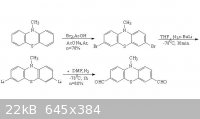DNA
Hazard to Others
  
Posts: 191
Registered: 11-6-2003
Location: @moon
Member Is Offline
Mood: Experimenting
|
|
lithiation of 8-bromoquinoline
Does anyone know what possibly could happen here.
Concerning the mechanism.

I haven't done many litation reactions so I don't really know in this case if it will attach twice to the precursor since t-BuLi is present as a dimer
usually and then I've read quite some about ortho litations so will it not kick of the bromine but attach next to the bromine?
[Edited on 5-8-2009 by DNA]
|
|
|
donlaszlow
Harmless

Posts: 33
Registered: 1-7-2008
Member Is Offline
Mood: 
|
|
It kicks the bromine off. I use lithiation to add formyl groups on phenothiazine rings, and if my goal is in positions 3 and 7, than I use
3,7-dibromo-10-methyl phenothiazine as a precursor.This is called the S. Ebdrup (1998) method. Yields are quite large (70-80%) in comparison to the
Vilsmayer-Haak method (20-40%).
So this is bad news for you 
I hope you find some method that might help
BTW I used n-BuLi
[Edited on 6-8-2009 by donlaszlow]

|
|
|
Jor
National Hazard
   
Posts: 950
Registered: 21-11-2007
Member Is Offline
Mood: No Mood
|
|
I don't think there is a + charge on the lithium 
|
|
|
Nicodem
Super Moderator
      
Posts: 4230
Registered: 28-12-2004
Member Is Offline
Mood: No Mood
|
|
No, there surely is no charge on lithium. That is an error. And the nitrogen on the lowest structure would have a formal (+) charge.
| Quote: | | I haven't done many litation reactions so I don't really know in this case if it will attach twice to the precursor since t-BuLi is present as a dimer
usually and then I've read quite some about ortho litations so will it not kick of the bromine but attach next to the bromine? |
No, t-BuLi, s-BuLi and n-BuLi all cause Li-Br exchange at -78°C. This is an incredibly fast exchange, approaching the speed of proton transfers even
though it is based on single electron transfer mechanisms. The difference when using t-BuLi is in that you use 2 equivalents in order to get a clean
reaction mixture (with n-BuLi you end up with n-butyl bromide besides the aryl lithium). The other equivalent is needed to eliminate the bromide from
t-BuBr so you end up only with LiBr, isobutane and isobutene as side products, which is important in some reactions where n-BuBr or s-BuBr interfere.
If you want to ortho-lithiate aryl halides you need to use lithium diisopropylamide (LDA) or lithium tetramethylpiperidide (LiTMP). With lithium
amides the Li-Br exchange is too much uphill in the thermodynamic sense that it does not occur (C-X vs. N-X bond!), so that the direct lithiation of
the neighbouring H is thus made possible. The acidity of ortho-H toward lithium in the aryl halides is F > Cl > Br > I (due to orbital sizes
and inductive effect). orho-Lithiated aryl halides are only stable at low temperatures. They often start to decompose to benzynes. Also, it is
important to understand that direct peri- and ortho-lithiation is a slow reaction in comparison to Li-X exchange (and with LDA and LiTMP it is also an
equilibrium reaction). Unless TMEDA is added, it can take several hours or heating up to -20 °C or even up to 20 °C, but this depends on the
directing group. Some directing groups like the R2NCOO- group will allow the lithiation to occur even at -78 °C in matter of minutes (for the
conditions required in regard to the directiong group see page 504 in The chemistry of organolithium compounds, Rappoport and Marek, 2004).
Also worth checking is Organolithiums: selectivity for synthesis, Clayden, 2002 and Organolithium methods, Wakefield, 1988.
…there is a human touch of the cultist “believer” in every theorist that he must struggle against as being
unworthy of the scientist. Some of the greatest men of science have publicly repudiated a theory which earlier they hotly defended. In this lies their
scientific temper, not in the scientific defense of the theory. - Weston La Barre (Ghost Dance, 1972)
Read the The ScienceMadness Guidelines!
|
|
|